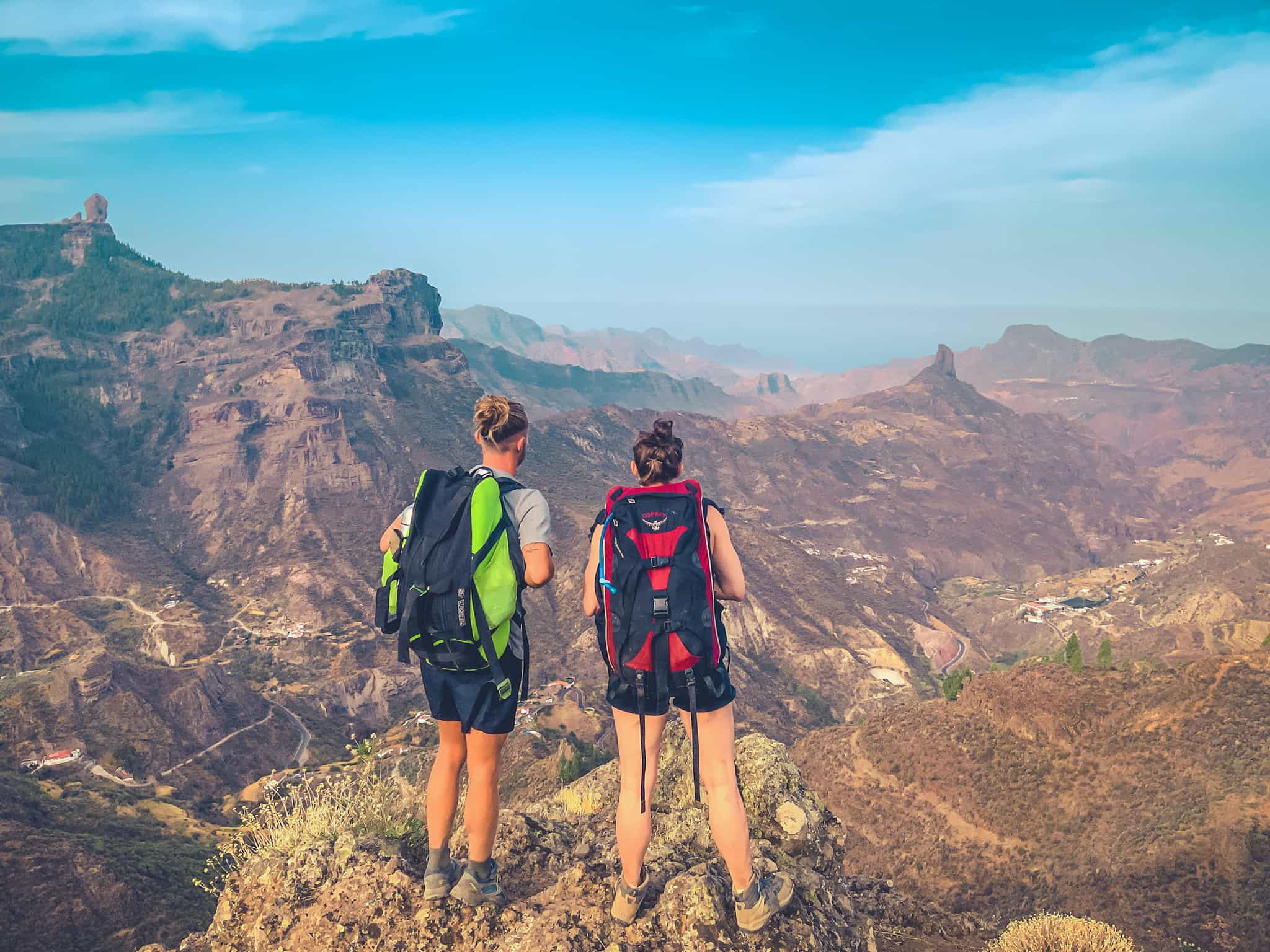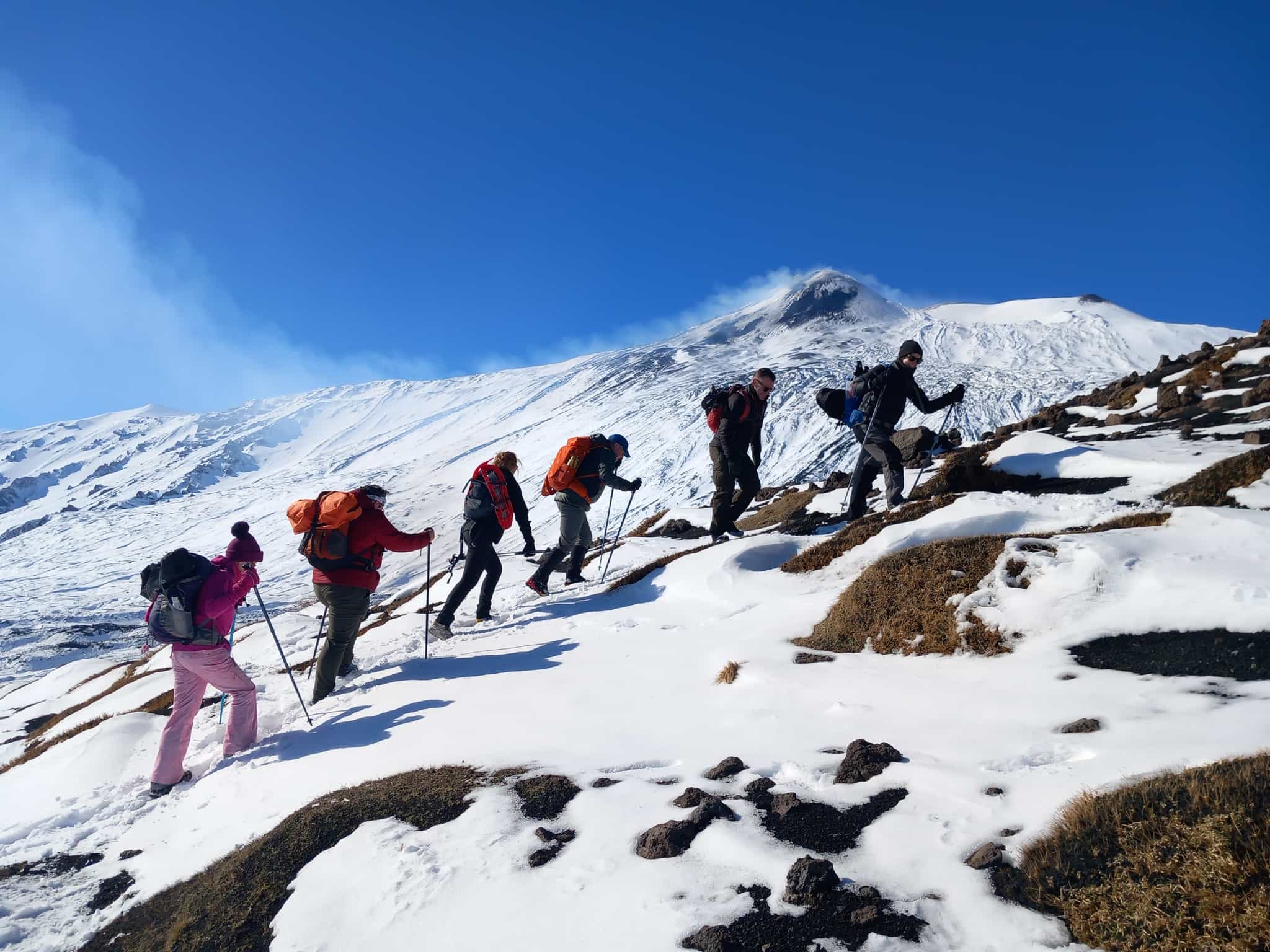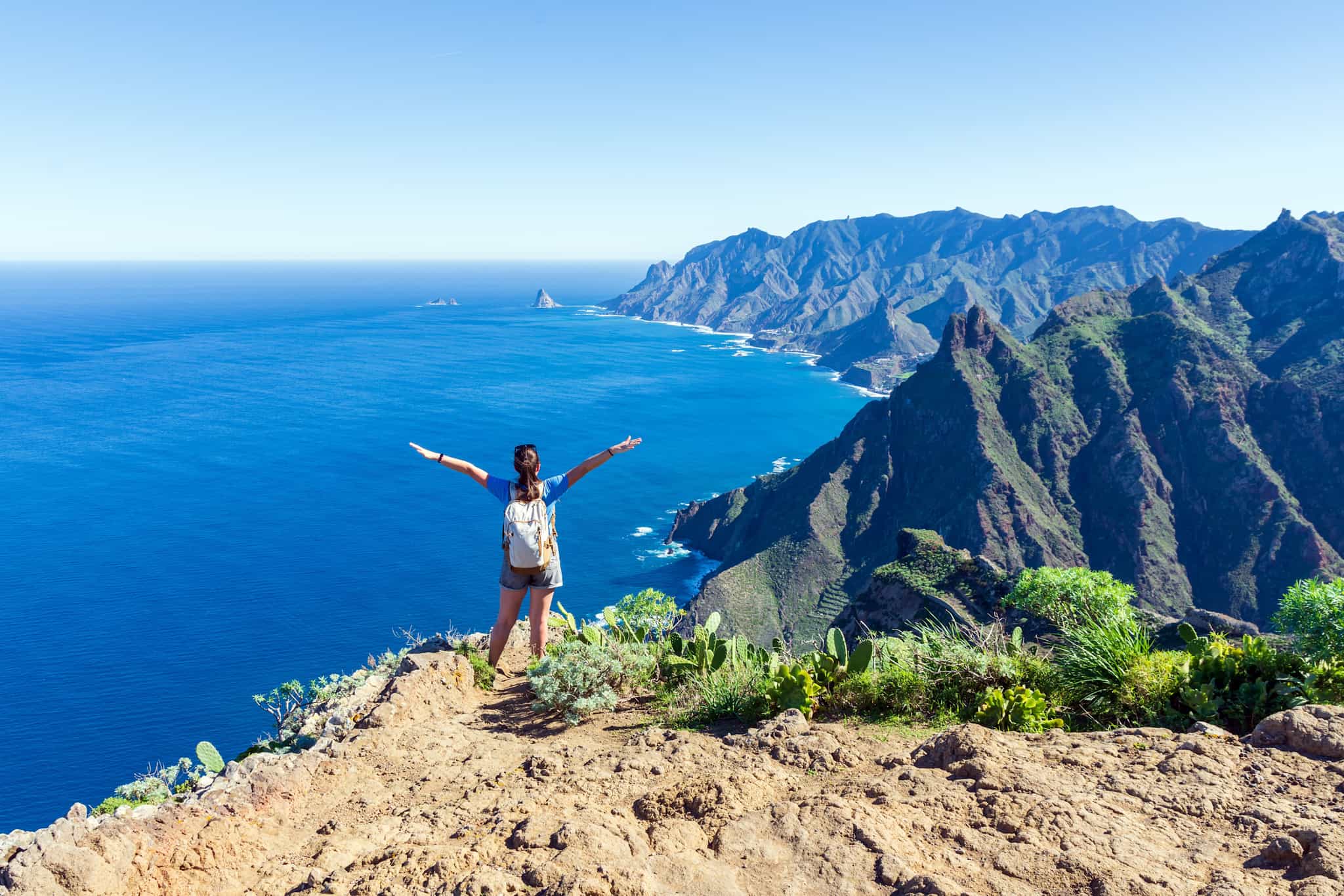Where to Go Hiking in Europe in January
January may not seem like the obvious time to pull on your hiking boots, but for those who crave solitude and landscapes transformed by snow, it’s one of the most rewarding months to explore Europe on foot.
The crowds of summer are long gone, replaced by a welcome stillness and the sense that you’ve stepped into a wilder, more authentic version of the continent.
From the glaciated peaks of the Alps to the sun-drenched trails of the Canary Islands, January hiking in Europe offers something for every adventurer. You might find yourself snowshoeing beneath the jagged spires of the Dolomites, treading frozen paths through Slovakia’s High Tatras or scrambling up the volcanic slopes of Mount Etna.
Whether you’re seeking winter sun or a test of endurance against the elements, these destinations prove that January isn’t about hibernating—it’s the ideal time for an adventure.
What’s the Weather Like for Hiking in Europe in January?
Europe is a diverse continent, and you’ll find wide variations in weather depending on the region you visit. The Alps are covered in snow; while high trails might be inaccessible, you can ski and snowshoe at lower altitudes. The days are often bright and crisp, perfect for enjoying the outdoors.
In Scandinavia, northern and Eastern Europe, you’ll experience frequent snowfall, frost-draped forests and sub-zero temperatures. Mountains will be dusted in snow. The temperatures are much milder in southern Europe. Head to the Canary Islands and you’ll be able to enjoy the winter sun.
At this time of the year, weather conditions can be unpredictable, especially at high altitudes. Anticipate rain, snow and limited visibility during blizzards. Pack waterproofs and warm layers of clothing.
Why Go Hiking in Europe in January?
Europe in January offers a rare stillness. The landscapes, stripped of their summer crowds, feel wild and unclaimed. Snow transforms mountain trails into ethereal worlds, where forests glitter with frost and peaks gleam under low winter light. In the Alps you can wander beneath skies of sharp, crystalline blue, crunching through a carpet of snow. Even in southern Europe, where the air is warmer, the villages and countryside take on a calmness perfect for quiet exploration.
Hiking in January is about intimacy—with nature, with local culture and with yourself. Trails that swarm with walkers in summer are blissfully empty. Locals have more time to talk to you and mountain hospitality is dialled up a notch, with roaring log fires and hearty Alpine cuisine. This slower rhythm allows you to connect more deeply to places you pass through.
Of course, it’s not all clear skies. This time of year the weather can change quickly, and you might experience sleet and snow. It’s very much the season for type two fun, so make sure you’re prepared, and have somewhere comfortable to warm up at the end of the day.
Best Hiking Destinations in Europe in January
1. Gran Canaria, The Canary Islands
- Average daytime temperatures: 19°C (66°F) to 21°C (70°F)
- Average nighttime temperatures: 14°C (57°F) to 16°C (61°F)
- Best for: Winter sun
Known as a ‘continent in miniature’, hiking in Gran Canaria takes you through a diverse range of habitats, from volcanic peaks to lush laurisilva forest and verdant gorges known as barrancos. The trails are also remarkably uncrowded, whatever time of year you visit, as Gran Canaria is (somewhat unjustly) better known for its beaches than its hiking.
Why hike here in January?: Located closer to the west coast of Africa than mainland Europe, you’ll be blessed with balmy weather compared to northern Europe.
Must-do trail(s): The day hike from Tejeda through pine forests and volcanically carved landscapes to Roque Nublo, an enigmatic rock monolith in the centre of the island.
What’s the weather like?: Delightfully mild at lower elevations. You can expect warm days between 19°C to 21°C, ideal for hiking. Climb to higher elevations and the temperature dips; you may also experience some rain and fog.
What to know before you go: It can also get chilly at night in the mountains. Pack warm clothes and waterproofs, just in case.
2. Tenerife, The Canary Islands
- Average daytime temperatures: 20°C (68°F) to 22°C (72°F)
- Average nighttime temperatures: 14°C (57°F) to 16°C (61°F)
- Best for: Warm winter weather
This ecologically diverse island boasts hiking trails through a wide range of landscapes—the ashy slopes of volcanoes, the serrated, forested peaks of the Anaga Mountains and gorge walks with ocean views . There are trails to suit hikers of different experience levels, from challenging summit hikes—such as an ascent of Mount Teide, the island’s highest peak at 3,715m (12,188ft)—to more laidback coastal strolls. Exploring on foot will enable you to immerse yourself in the island’s wild beauty, which few tourists experience.
Why hike here in January?: Tenerife in January offers warmer hiking conditions for those wanting to escape the winters of the northern latitudes.
Must-do trail(s): The Masca Gorge Trail, from the hillside town of Masca to the coast, is one of Tenerife’s most well-known hikes. Visit Teide National Park to hike through the Chinyero eruption zone towards the high plains of Las Cañadas del Teide, or complete a circuit through the Anaga Rural Park towards Mirador de Aguaide.
What’s the weather like?: Temperatures are mild and pleasant, particularly in the south of the island. It can be cooler and cloudier further north, in areas such as Anaga Rural Park, but any rain showers tend to be brief.
What to know before you go: The 6th of January is a public holiday in Tenerife (Los Reyes Magos) so some restaurants and attractions might be closed.
3. High Tatras, Slovakia
- Average daytime temperatures: 5°C (41°F) to -5°C (23°F)
- Average nighttime temperatures: -9°C (16°F) to -17°C (1.4°F)
- Best for: Untracked trails through the forest
Slovakia’s High Tatras Mountains are beautiful year round, but during the winter months they transform into a fairytale landscape of frozen lakes and snow-drenched forests, encircled by white peaks. Stay in the winter resort of Stara Lesna and there are plenty of trails from the door, including a challenging six hour hike to the aptly named Green Lake. Most hotels here have a jacuzzi or sauna where you can warm up after a day out in the cold.
Why hike here in January?: The High Tatras region is spellbinding during the winter months. Think ice-capped mountains surrounded by forests of pine trees dripping in snow. Plus, the region’s thermal baths are particularly appealing this time of year.
Must-do trail(s): Hike through the Mengusovska Valley, a lost world of jagged peaks, dramatic rock faces and snow-laden pines, towards Lake Popradske.
What’s the weather like?: Expect the weather in this mountainous region to be snowy and cold, with the temperatures often below freezing.
What to know before you go: Some trails in the High Tatras, those leading to peaks or high saddles, close between November and June. Huts at higher elevations are also closed. However, there are plenty of lower elevation huts and trails still open. Visit the Tatras information site to find out more.
4. Fort William, Scotland
- Average daytime temperatures: 3 °C (37°F) to 6 °C (43 °F)
- Average nighttime temperatures: -3°C (27°F) to 3°C (37°F)
- Best for: Type two fun
Fort William is located at the foot of Ben Nevis, on the shores of Loch Linnhe. Thanks to this spectacular scenery it’s known as the ‘outdoor capital’ of the UK, attracting climbers, hikers and cyclists all year round.
Why hike here in January?: The mountains and munros in the Fort William area are an ideal location for experienced hikers to test and hone their winter mountaineering skills. The weather is wild this time of year, so make sure you do so with an experienced guide.
Must-do trail(s): Experienced hikers can attempt a winter ascent of Ben Nevis with a local mountain guide. An easier option is the short hike through Nevis Gorge to Steall Falls, a cascade that often freezes during the winter months.
What’s the weather like?: Cold and often wet, with temperatures often dropping below freezing at night. Head up into the Highlands and you can expect snowfall, blizzards and high winds.
What to know before you go: Daylight hours are at their lowest this time of the year, so make sure you allow enough time for hikes.
5. The Dolomites, Italy
- Average daytime temperatures: -4°C (25°F) to 4°C (39°F)
- Average nighttime temperatures: -11°C (12°F) to -4°C (25°F)
- Best for: Off-season exploration
The Dolomites are an iconic mountain range, with their serrated peaks and towering limestone cliffs. They’re criss-crossed with hiking trails and via ferratas, remnants from moving troops during WWII.
Why hike here in January?: You’ll discover a completely different side to the Dolomites outside of peak summer season. While travellers flock to the ski slopes this time of year, the hiking trails through alpine meadows and forests remain blissfully untouched.
Must-do trail(s): Hike up through the Val Fiorentina to cosy Refugio Belvedere, nestled just below Monte Fertazza. You can have lunch here before heading back.
What’s the weather like?: The weather often drops below freezing, and you can expect snow. Days are often sunny and crisp, but this being the mountains the weather can be unpredictable, with sleet and poor visibility on occasion.
What to know before you go: Most mountain refugios—aside from those located on ski slopes—are closed during winter, so this is not the best time for hut-to-hut hikes. Use one of the mountain towns as a base and enjoy a series of day hikes from the door instead.
6. Lofoten Islands, Norway
- Average daytime temperatures: -2°C (28°F) to 3°C (37°F)
- Average nighttime temperatures: -7°C (19°F) to 0°C (32°F)
- Best for: Northern lights watching and frozen beach-scapes
The Lofoten Islands are located north of mainland Norway, high in the Arctic Circle. The archipelago is renowned for its sublime natural beauty, from its wild beaches to its jagged volcanic peaks and the red fishing huts nestled into its rocky shore.
Why hike here in January?: The island is dotted with saunas where you can warm up after a day of exploring. Once the sun goes down you might see the northern lights flickering overhead.
Must-do trail(s): Hike up to Ryten, one of Lofoten's most iconic viewpoints, looking down on Kvavlika Beach, carpeted in snow this time of year.
What’s the weather like?: Expect snow this time of year. Located within the Arctic Circle, you’ll find that days are short, too—the temperatures plummet after dark.
What to know before you go: This is the Arctic, so you might get bad weather this time of year. Be flexible when it comes to planning hikes and other activities.
7. Carpathian Mountains, Romania
- Average daytime temperatures: -3°C (27°F) to 2°C (36°F)
- Average nighttime temperatures: 0°C (32°F) to -6°C (21°F)
- Best for: Solitary hiking and underground caves
The Carpathian Mountains arc through the centre of Romania, karst peaks surrounded by some of Europe’s most extensive virgin forest. They’re a habitat for large carnivores such as brown bears, wolves and lynxes. Head to the lesser-visited Apuseni Mountains (the Western Carpathians) to discover an untouched landscape of deep river gorges, twisting caves and dense forest.
Why hike here in January?: For the fairytale forests and the completely untouched landscape. Chances are you won’t meet a soul as you crunch in meditative silence across the snow.
Must-do trail(s): The hike to Vârtop Cave, famous for its imposing stalagmites and stalactites and fossilised Neanderthal footprints. The Tauz karstic spring, a deep underwater cave at the foot of a rock wall, is also worth a visit.
What’s the weather like?: In this mountain environment, temperatures are often around zero degrees during the day, dropping lower at night. Expect plenty of snow.
What to know before you go: Navigating the mountains is difficult in January, thanks to ice and snow on the roads and very little public transport. A private tour is your best method of transportation during winter.
8. Sicily, Italy
- Average daytime temperatures: 13°C (55°F) to 15°C (59°F)
- Average nighttime temperatures: 5°C (41°F) to 7°C (45°F)
- Best for: Volcano hikes
The Italian island of Sicily is blissfully deserted during the winter months. The villages are empty save for a few locals and the hiking trails are uncrowded. Follow a route along the windswept coast, or through the Anapo River gorge to the Bronze Age necropolis of Pantalica. Or you could go big and head up towards the snowy heights of Mount Etna (3,403m/ 11,165ft) for a challenging multi-day trek.
Why hike here in January?: Seeing the stark black volcanic slopes of Mount Etna carpeted with snow – this is a surreal landscape of fire and ice.
Must-do trail(s): The Pista Altomontana, a path that circles Mount Etna, at an average altitude of 1,800m (5,906ft).
What’s the weather like?: At sea level the temperature is relatively mild, and there are some rainy days. Temperatures drop considerably as you climb Mount Etna, and snow is likely at altitudes over 1,600m (5,249ft).
What to know before you go: Chances are, you won’t be able to reach the summit of Mount Etna this time of year. To do so you need technical knowledge and equipment. Even with this, poor weather conditions can prevent you reaching the top.
9. Rila Mountains, Bulgaria
- Average daytime temperatures: -3°C (27°F) to 5°C (41°F)
- Average nighttime temperatures: -11°C (12°F) to -4°C (25°F)
- Best for: Snowy summit hikes
The Rila Mountains are Bulgaria’s highest range, a wilderness of stony peaks, forests and glacial lakes protected within Rila National Park. The north is more accessible, dotted with huts and the famous Rila Monastery—a UNESCO World Heritage site nestled in a forested valley—while the south and west are wilder, quieter, and perfect for those who prefer solitude. You can adventure here year round, snowshoeing and skiing during the winter months.
Why hike here in January?: The area is well set-up for winter adventuring, with chair lifts to transport you up the peaks, huts open at lower elevations and hotels with thermal pools and saunas.
Must-do trail(s): The Seven Rila Lakes Trail, which takes you across a plateau encircled by mountains to a series of frozen lakes.
What’s the weather like?: In this mountainous region, weather is cold and snowy during the winter months, the temperature often dropping below freezing.
What to know before you go: Comforting, hearty Bulgarian mountain cuisine comes into its own during the winter months. Try gyuvech, a slow-cooked stew, or kapama, a dish made with roast meat, rice and sauerkraut.
10. The Julian Alps, Slovenia
- Average daytime temperatures: -4°C (25°F) to 3°C (37°F)
- Average nighttime temperatures: -10°C (14°F) to -5°C (23°F)
- Best for: Dreamy Alpine solitude
Slovenia’s Julian Alps are a pristine adventure playground of lush Alpine meadows, stony peaks and deep blue lakes. Summer is the season for wild swimming and summit-bagging, but in winter life slows down as a blanket of snow carpets the landscape. Visitors can enjoy visits to idyllic mountain villages, and hikes through snow-drenched forest and past frozen waterfalls. You can even go kayaking in flooded underground mines.
Why hike here in January?: Slovenia’s mountain huts and hotels are cosy during the colder months. Many have spas and saunas so you can stay nice and toasty in the evening.
Must-do trail(s): Hike a small section of the long-distance Alpe Adria Trail through Triglav National Park for breathtaking mountain views.
What’s the weather like?: Snowfall is common during January, with temperatures often dropping below freezing.
What to know before you go: It’s just a short distance across the border into northeastern Italy. Visit the Laghi di Fusine, two forest-shrouded glacial lakes which freeze over in winter.
What to Pack for Hiking in Europe in January
Here’s an example kit list for a snowy trip to go hiking in Europe in January. We’ve taken it from our Winter hiking in the Italian Dolomites trip page. You’ll need fewer warm clothes if visiting somewhere warmer, such as the Canary Islands.
Bags
Small cabin luggage or duffel bag Daypack (approx.30 liters) Waterproof liner/drybags for keeping the contents of your pack dry
Clothes
Rain/windproof (Gore-Tex) jacket with hood Rain/windproof (Gore-Tex) trousers (we recommend either a combination of a thermal layer and a waterproof hard shell trouser, or insulated waterproof skiing pants) Fleece jacket or similar Thermals (merino best) One or two functional shirts (we recommend merino or synthetic) Warm hat Warm waterproof gloves, with liners Buff or neckscarf Trekking trousers/shorts/skirts Underwear and one or two layers of socks (merino or synthetic) Sunglasses (cat 3 lenses or higher recommended, suitable for bright conditions) Snow goggles (recommended, for bad weather conditions) Sleepwear Swimwear and flip flops (for the wellness centre) Comfortable, 3-season, waterproof hiking boots (above ankle essential) and not rigid 4-season boots. A pair of comfortable shoes for the evenings
Other
Universal travel plug adapter Power bank or solar charger (optional) Passports (and visas) Travel insurance documents Ear plugs Suncream (SPF30+ recommended) and lip balm Personal first-aid kit (inc. blister treatment) Personal items (biodegradable toiletries, sanitary wear etc) Alcohol hand-gel Reusable water bottle 2 x 1 litre Energy bars and snacks
FAQs
Which European countries are good for hiking in January?
The Canary Islands are good for hiking in January, with warm weather all year round. Other options include Spain and Portugal. For wintry options, visit France, Italy or Norway.
Where to go alpine hiking or snowshoeing in January?
Europe has lots of options for alpine hiking or snowshoeing, including Romania’s Carpathian Mountains, the Julian Alps in Slovenia and Lahemaa National Park in Estonia.
Which regions in Europe have snow-free trails in January?
To hike in warmer weather, head to southern Europe. You’ll find snow-free trails in southern Spain, Portugal and the Canary Islands.
What long-distance trails are accessible in Europe in winter?
During the winter months, you can hike long-distance trails in southern Europe such as the Rota Vicentina in Portugal, the trails of the Camino de Santiago network or the GR131, a 348 mile (560km) trail across the Canary Islands.
Is it safe to go hiking in Europe during January?
Hiking in Europe during January is safest in low-altitude regions with well maintained trails and milder weather, such as parts of Spain, Portugal and the Canary Islands. In high-altitude areas like the Alps, weather will be more unpredictable and there is a risk of avalanches. Having the correct gear, checking the weather and travelling with an experienced guide reduces the risk of accidents.
Which is better for January hikes, Madeira or Azores?
Madeira has a sunnier and more stable climate during the winter months, making it a better option for winter hiking than Azores. However, there’s a chance of rain on both islands, so come prepared with waterproofs.
How can I hike safely in the Dolomites or Pyrenees in January?
To hike safely in any Alpine environment during the winter months, you need to wear the correct gear, such as warm, waterproof clothing and technical hiking boots. Steer clear of trails at high altitudes, which may be impassable due to snow. At this time of year, travelling with an experienced local guide is highly recommended.
Where to find multi-day hut-to-hut hiking in winter in Europe?
You can find hut-to-hut hiking in areas such as the Dolomites, Slovenia’s Julian Alps and Romania’s Carpathian Mountains. However, huts servicing higher altitude trails are often closed for the winter months, so make sure to check what’s open in each individual region.
What winter hiking routes in Europe offer challenging elevation gain?
Challenging winter hikes include routes in the Dolomites, such as hiking to Rifugio Belvedere (2,082m/ 6,831ft) from the mountain town of Pescul, an elevation gain of 700m (2,297m), or the trails up the slopes of Mount Etna in Sicily. For a challenging summit hike, consider Justadtinden (738m/ 2,421ft) in Norway's Lofoten Islands.
How can I insure my winter hiking holiday (covering high-risk terrain)?
Choose an adventure-specific insurance provider which offers cover for a wide range of adventurous activities, including winter hiking or mountaineering. True Traveller (for those based in the UK or Europe), or Rise + Shield, are both frequently used by adventure travellers.
Where to rent winter trekking equipment in Europe?
You can rent winter trekking equipment online, through companies such as Outdoor Hire or Rab rental, or through specialist providers in your destination of choice. If you choose to go on a guided winter trek, your tour operator will provide you with the specialist gear you need.
What are the best guided hiking tours in Europe for January departures?
Much Better Adventures has plenty of options for guided hiking tours in January, including a long-distance trek across Gran Canaria, a hiking trip in the Italian Dolomites and to Romania’s Carpathian Mountains.
What are the best winter hiking packages for experienced trekkers in Europe?
Some of the best winter hiking packages include Much Better Adventures’ Hike the Volcanic Island of Gran Canaria adventure, a multi-day hike from the volcanic interior to the coast, and a long weekend hiking Mount Etna.
Can I join a snowshoe expedition or mountaineering course in Europe?
Yes, you can. You can summit Ben Nevis and learn winter mountaineering skills, or snowshoe up the snow-covered slopes of Mount Etna.
Are there easy winter hiking options in Europe?
Yes, Europe offers some excellent options for easy winter hikes. Consider exploring the Logar Valley in Slovenia's Julian Alps, the snowshoeing trails of Finland's Pyhä-Luosto National Park or the pine forests of Estonia's Lahemaa National Park.
Stay safe out there: Our guides are well-researched, short summaries, designed to inspire but not for navigational purposes. While we strive for accuracy, we cannot guarantee completeness. Outdoor activities come with serious risk, and individuals must take full personal responsibility for their own safety. Much Better Adventures, and the authors, disclaim any liability arising directly or indirectly from the use of the information from this article.











